How comfortable are real people with using voice commands with their devices?
We wanted to know, so for the second year in a row, we asked over 1,000 people how they use voice, when they use voice, and why. If you’re looking to get a snapshot of how voice is used by people today, then you’ve found it.
So, why do we care? Simple: The voice revolution is coming, and it’s coming fast. In just two years, it’s likely that you will spend as much, or more, time interacting with devices that have no screen as you do with devices that have screens, such as laptops and smartphones. This has the potential to drive huge changes in the market, including new winners and losers—and you want to be one of the winners. (Well, I know I do!)
For reference, here is a link to last year’s survey.
For many of the survey questions shown as bar charts, we asked participants to answer whether or not they were willing to do something as follows:
- Very Likely
- Likely
- Neutral
- Unlikely
- Very Unlikely
Unless specified otherwise, these charts show the totals of the “Very Likely” and “Likely” responses. We received 1,036 valid response to our 2018 survey.
In addition, for many of the other survey questions shown as bar charts, we asked participants to answer whether or not they were willing to do something as follows:
- Very Frequently
- Frequently
- Occasionally
- Rarely
- Never
Unless specified otherwise, these charts show the totals of the “Very Frequently” and “Frequently” responses.
Did you know that you can “Ask Perficient Digital” SEO & digital marketing questions on Google Assistant and Amazon Alexa devices? Here’s how to do it!
In What Environments Do People Use Voice?
This block of 10 questions is meant to break down how various public and private situations impact people’s willingness to use voice commands. Here is a look across all survey participants:
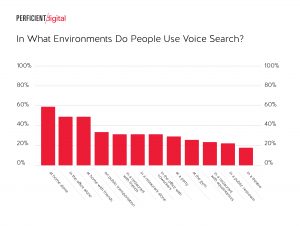
How did this change from last year? Well, let’s take a look:

Willingness to use voice with their smartphone when at home and alone is down between the two surveys. This dropped from about 66% to 59%. However, my guess is that the numbers are essentially the same, given the sample sizes.
However, notice the significant increases in willingness to use voice commands in various public venues. At a party, at the gym, at a restaurant with acquaintances, in a public restroom, and in a theater all increased significantly. In some cases, the willingness has more than doubled.
[Tweet “Survey shows that people became more willing to use voice commands with their mobile devices over the past year. Learn more at”]
We also measured how men and women differ with regard to using voice commands. Just as last year’s survey showed, we still see a difference in use between genders:

However, the gap looks like it may be closing. In aggregate, we determined that men were 1.77 times more likely to use voice commands in last year’s survey, and this year that ratio has dropped to 1.59.
[Tweet “Men are still more likely to use voice commands with mobile devices in public places, but survey shows women are overcoming their reluctance. Learn more at” ]
Next up, let’s examine how age influences the level of usage. Here is what we saw:

In last year’s survey, the 18 to 24 age group was the most aggressive for using voice commands in public places, but this year it’s the 25 to 34 age group. For at home with friends, and on public transportation, 45+ is the clear winner. The data seems to indicate that the sensitivity to age is decreasing overall from last year.
[Tweet “Young people are still most comfortable with using voice commands to their device in public, but acceptance in older generations is growing. See all the data at”]
Marital status also seems to matter. Here’s a look at the data:
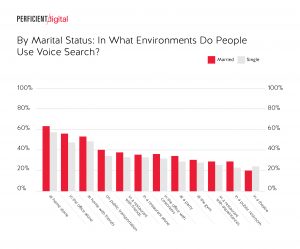
Married people are more likely to use voice in every single category, except one. That’s the “in a theater” category. Perhaps using voice commands while sitting next to your spouse is frowned upon?
Last year we captured the income levels of the participants, and we did this year as well. Here is what we got:
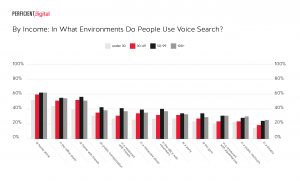
People who make $50K to $99K were the most likely to use voice commands (41.5% in aggregate across all environments). Last year it was the $100K+ income category, but our $100K+ folks were only slightly behind in total usage (39.4% in aggregate across all environments).
These numbers are extremely close to one another, and it’s clear that the tendency is for higher income people to use voice commands more. I did check into this a little further and found that the $50K to $99K income bracket is also younger on average than the $100K+ group, and this is likely why these categories balance out the way they do.
New to this year’s survey, we capture information on the region where people were located. Let’s see how this impacted voice usage levels:
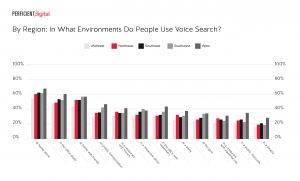
It’s not entirely surprising that this is dominated by the Western region. Of note, 35% of people in the West use voice commands with their devices in public restrooms. Here are the regions in rank order:
- West
- Southwest
- Southeast
- Northeast
- Midwest
The Midwest ranked last in every single category, except in the “in the office with coworkers” category were is barely edged out the Northeast.
[Tweet “Survey finds West Coasters most likely to use voice commands with mobile devices, with Mid-Westerners least likely. See the complete mobile voice trends survey at”]
Also new to this year’s study, we captured information on the education level of the participants. Here’s the data for that:
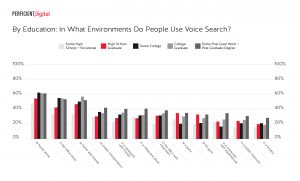
It looks like some postgraduate work combined with those who have a postgraduate degree are the heaviest users. In fact, voice usage seems to scale with education level:
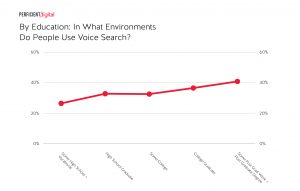
[Tweet “Comfort with using voice commands with a smartphone increases with education level. See this survey for other interesting findings about mobile voice usage:” quote=”Comfort with using voice commands with a smartphone increases with education level. “]
How People Use Voice with Their Smartphones
In this next section, we explore the way people use voice from a number of perspectives, as well as other ways that they interact with their smartphones. Our first question explored how they conduct searches, and the phrasing was, “When I need to look up information, I am most likely to … (Please rank your top three choices).” These are the choices we gave them:
- Use voice search
- Type the question into the search window of my phone
- Type the question into search engine apps
- Open a mobile browser such as Safari or Google Chrome, and type the question
- Ask a friend via text or messaging app
We asked them to prioritize each choice as “Most Likely”, “Likely” or “Unlikely.” There were two choices that were unranked for every participant. First, let’s look at the breakout of what people said was their “Most Likely” choice:
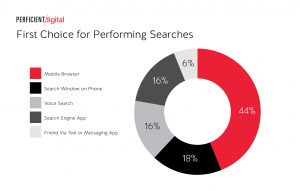
Next, let’s look at the distribution of what people selected across all three of their choices:

As we see, the use of a mobile browser is by far the number one choice. However, across all users, 60% use voice search some of the time. It’s also interesting to see that text/messaging app is used some of the time by nearly 50% of the survey respondents.
Taking a deeper look at texting and messaging, you can see a clear trend of usage by age, as shown in this graph:
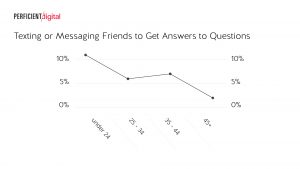
This chart reflects the selection of texting/messaging apps as a first choice. Bottom line is that as time passes and the current generation matures, chances are that texting and messaging apps will be an increasingly common way to obtain answers to questions. This trend is likely to grow alongside the growth of voice usage.
[Tweet “Survey shows younger people more likely to seek answers to questions from friends via text or messaging apps, but older generations catching up. Learn more at”]
There is actually some real interaction between these two trends. In the next question, we asked people “Which of these applications have you controlled with voice commands? (Please select all that apply)”. Responses were as follows:
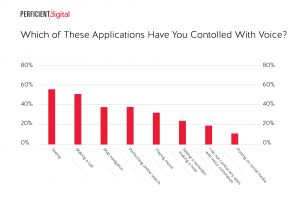
Texting came in as the number one app that people had used voice with, at 56%. Also of interest is that men were higher in usage than women in nearly every application. Most notably, men were more likely to play music via voice commands than women by a 39% to 26% margin. The one app that women were more likely to control by voice than men? Texting, by a 59% to 53% margin.
[Tweet “Survey shows people use voice with mobile devices to send a text or start a phone call most often. Women are more likely than men to text by voice. Learn more at”]
The next question explored when people were most likely to use a voice command. The way we phrased the question was, “In which of these situations would you be more likely to use voice commands on your smartphone instead of using your hands? (Please check all that apply).” Here are the results we obtained:

[Tweet “Survey shows people are most likely to use voice commands with mobile devices when driving. Get 30 more fascinating mobile voice trends from this study!”]
Men also lead most categories here, but women lead the use of voice while driving 61% to 54%. We dove a bit more deeply into this area, and asked participants, “How often do you use voice commands while driving?”:

Combining the “Very Frequently” and “Frequently” categories of responses, we get 31%, whereas combining the “Rarely” and “Never” categories, you get 37%. In contrast to the prior question, men led for this question by a 39% to 29% margin. Bear in mind that the prior question was about when you would be “most likely to” use voice commands, not how often you did so, which is the topic of this question.
Delving into this a bit more, for this question, 26% of women used voice commands while driving “Very Frequently” or “Frequently”, while 42% did so “Rarely” or “Never”.
Why are people reluctant to use voice commands while driving? We asked them: “Do you think using voice commands while driving is distracting?” The responses were as follows:
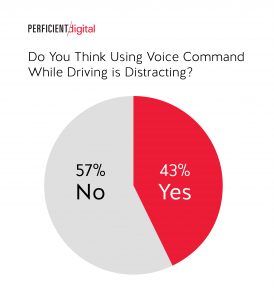
Of course, if the law in your state prohibited you from dialing numbers by hand, that might encourage you to use voice for dialing more. To find out about that, we asked: “Is there a hands-free driving law in your state?” This is what the participants said:

It was a bit concerning to see a full 30% indicating that they don’t know. Most states with these laws plaster their highways with signs to make people aware of the law.
For our next question, we asked our participants: “How often do you use voice commands with devices other than your phone, e.g. laptop, smart TV, watch, a virtual assistant)? Here is what they said:
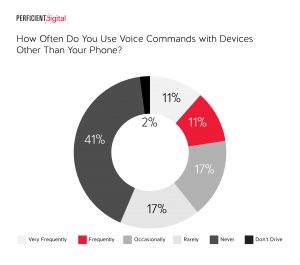
Here we get 22% of people who do so “Very Frequently” or “Frequently”, and 58% who do so “Rarely” or “Never”. Interestingly enough, among those who make $100K or more per year, 33% of them do so “Very Frequently” or “Frequently”, and for the $50K to $99K income range, this still comes in at a strong 29%. I suspect that this may be due to the growth of the smart speaker market segment. The male bias here is very strong as well, with men outpacing women by a 31% to 17% margin.
[Tweet “Most people in this survey still don’t use voice commands on devices other than their phones, but that’s changing among upper-income groups, perhaps reflecting the growing smart speakers market. Learn more at” ]
We then asked people: “What is your preferred method of sending a text message?”, and got the following responses:
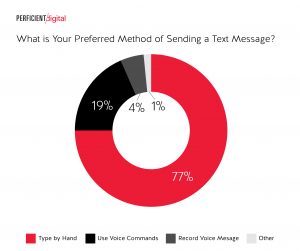
You can see that typing by hand dominates this question, but using voice to enter in your text is used by 19% of people. Sending your text as a recorded voice message is something that 4% of users prefer to do. Men are more likely to use voice to text by a 26% to 14% margin, and women are more likely to type it in by hand by an 81% to 70% margin.
We also wanted to explore basic smartphone usage behaviors, and one of the questions we used to do that was: “How do you usually place a call on your smartphone (Please select all that apply)?”. Results were as follows:
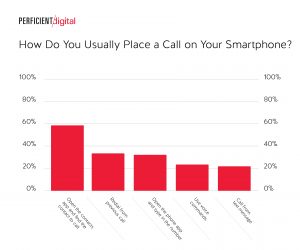
Voice actually came in fourth for this question, with 24% of respondents selecting it. This was a surprise to me, as using voice commands to make calls is a great way to keep your hands on the wheel and eyes on the road while driving.
The next question along these lines explored: “How do you usually talk on the phone (Please select all that apply)?”. Here is what the survey said:

Phone to Ear wins this question at 73%. This skews a bit toward lower incomes, with people making less than 30K putting the phone to their ear 77% of the time. Wired headsets still score well at 26%. Men are far more likely to use a wired headset than women by a 33% to 21% margin.
Our next question was: “When using a search engine or a personal assistant (Google Assistant, Siri or Cortana) on your smartphone, what do you like most about using voice commands (Please rank your top three choices)?” The results were as follows:
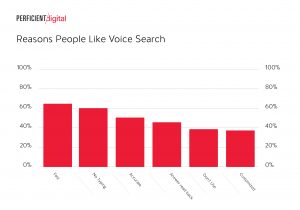
Speed was the number one response, followed by No Typing. Interestingly enough, people with incomes over $100K cited speed as their main reason 43% of the time. It should be no surprise that they’re naturally impatient.
[Tweet “When asked what they like best about interacting with digital assistants by voice, most people said speed and lack of typing. Get more mobile voice trends at”]
Next up, we asked people about the quality of speech recognition, with this question: “How well do your built-in personal assistants on your phone, such as Google Assistant, Cortana, and Siri, understand you?” Here is what we got:
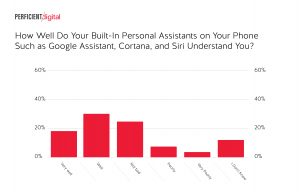
Very Well and Well came in right at 50%, and when you add Not Bad, the total goes up to 75%. The $100K income category was at 56% here, and the $50K to $99K category came in at 58%. Men also felt better than women about their devices understanding them by 58% to 45%.
[Tweet “Survey shows that the majority of people feel their smart devices understand their voice commands pretty well. Get more mobile voice trends at”]
The follow-up question to that one was: “How comfortable are you accessing Siri or Google Assistant, by holding down your home button?”. Respondents replied as follows:
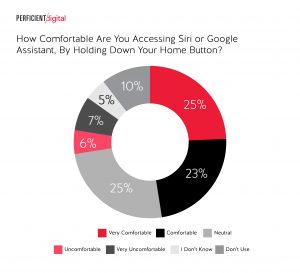
Very comfortable / Comfortable: 48% Uncomfortable / Very uncomfortable: 13% Neutral: 25% Don’t use: 10% Don’t know; 5%
For users that answered very uncomfortable or uncomfortable, we asked them to clarify why. Responses were as follows:

Women were a lot more annoyed by this than men by scores of 41.6% and 30.1%.
For our next question, we asked: “Would you use voice to unlock your phone if it were an option?” The responses were as follows:
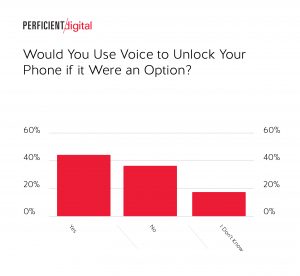
[Tweet “Would people welcome using their voice to unlock their smartphones? The answer may surprise you!” ]
One of the reasons is the reluctance to bother others when we do it. We decided to explore just how real that fear is, and asked, “Do you agree with these below statements? I feel annoyed when I hear someone use voice commands on their phone in a public setting.” Here is what people said:

This question skews toward higher incomes in a big way, as 62% of those who make $100K+ get annoyed, and 50% of those who make $50 to $99K do. Since higher education correlates well with income, it makes sense that this is a factor as well, as you can see in this chart:
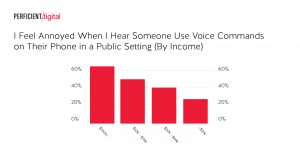
However, it stands to reason that the reason why it’s attractive to use voice commands is that it is convenient. To find out what people thought of that, we asked, “Do you agree with these below statements? Voice commands make using my smartphone easier.” Here are the results:

It should be no surprise that higher incomes appear to see the value more, with 58% of those who make $100K+ strongly agreeing or agreeing with the statement, and 59% of those in the $50K to $99K income category.
[Tweet “In a survey, a majority of smartphone users agree voice commands make using their devices easier. Get more mobile voice usage trends at” ]
We also wanted to explore what features people want most from their personal assistants in the future. That led us to ask: “When using a search engine or a personal assistant (Google Assistant, Siri, or Cortana) on your smartphone, what features related to voice commands would you like in the future (Please select all that apply).” This is what the respondents said:

”More direct answers” was the winner last year, too. Interestingly, on iOS, 48% of users want this, but on Android, only 38% of them do.
For our second-to-last question, we asked: “Are you comfortable activating/accessing Siri or Google using your voice commands, such as Hey Siri, OK Google, or Alexa?”
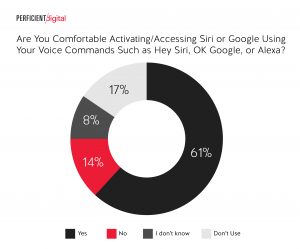
So it looks like most people are pretty comfortable with these commands.
Our final question was grounded in a mistaken impression on our part. We asked people, “Are you aware that all your conversations are recorded when you have “Hey Siri”, “OK Google” or “Alexa” enabled?”
Before presenting the answer, I should clarify that both Amazon and Google have publicly indicated that the recordings of what you say are only kept locally on the device, and they are discarded after a period of time (6 months). This information is NOT sent back to its data centers. The only information that is sent to their data centers are the actual commands that you provide to the personal assistant. With that clarification, here were the responses:

For reference, here are articles that provide some background on the information retention policies of Amazon and Google:
- Can Amazon Testify Against You?
- Relax, Your Amazon Echo Isn’t Recording Everything You Say”
- How Google Home’s Always On Will Affect Privacy
Summary
That was a lot of data to read, no doubt (imagine how much work it was to process it!), but it’s important for all digital marketers to understand how quickly the voice revolution is coming. There are so many trends driving this:
- People becoming more used to using voice commands with their devices.
- The rise of the Internet of Things. Some forecasts say that 75% of all Internet-connected devices will be something other than a tablet, PC or smartphone by 2020. Many of these devices will be browserless.
- The rise of digital personal assistants. As their usefulness grows, adoption will scale, and the presumptive interface will be voice.
- The rise of smart speakers. Sometimes a revolution needs a spark to start it, and it may just be that the smart speaker market explosion that is now in progress is that spark.
How fast will we reach a billion users who view voice as one of the primary methods for interacting with their devices? I have no perfect crystal ball for this, but my belief is that we’ll be there in less than five years. This is a large and disruptive market change, so the time to start thinking about this is now.
Keep on learning! Find out which personal digital assistant is the smartest.

